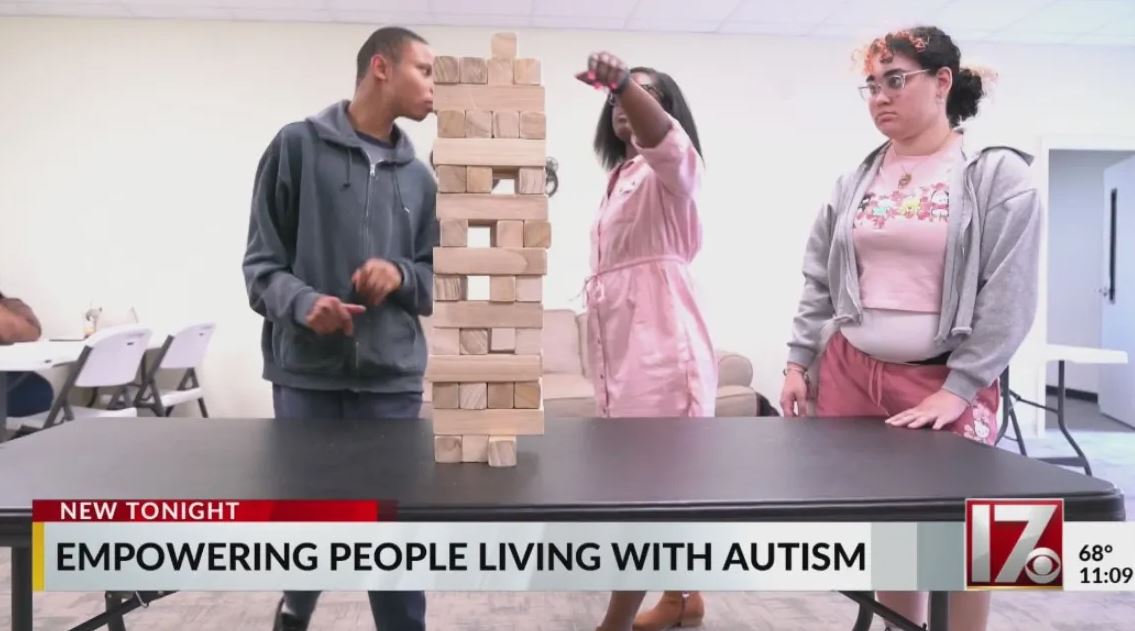Understanding the Intense Stare Phenomenon

Understanding Staring Behaviors in Autism
Autistic individuals may exhibit unique staring behaviors that can be distinct from typical eye contact patterns. It's important to recognize that these behaviors vary among individuals, and everyone's experience is unique. In this section, we will explore the reasons behind staring in autism and the impact it can have on autistic individuals.

Reasons for Staring in Autism
Staring behaviors in autism can have various motivations. Autistic individuals may engage in staring as a means of observing and understanding behaviors and interactions, similar to how Jane Goodall observed chimpanzees to better understand their behavior. It can be a way for them to gather information and make sense of the world around them. The intense stare phenomenon may stem from curiosity and a desire to comprehend social cues, expressions, and nonverbal communication.
For some individuals with autism, staring can also serve as a self-regulatory mechanism. It may provide a sense of comfort and stability in overwhelming or unfamiliar situations. By focusing their attention on specific objects or individuals, autistic individuals may find a sense of predictability and control in their environment.
It's important to note that the reasons for staring can vary widely among autistic individuals. Each person may have unique motivations for engaging in this behavior, and it's crucial to approach it with understanding and respect.
Impact of Staring on Autistic Individuals
The impact of staring behaviors on autistic individuals can be multifaceted. Autistic individuals may face challenges in social interactions due to their staring behaviors. It may lead to misunderstandings or misinterpretations from others who may not be familiar with these behaviors. The intense stare phenomenon can sometimes be perceived as invasive or uncomfortable by non-autistic individuals.
Moreover, autistic individuals may face difficulties in establishing and maintaining social connections due to their atypical eye contact patterns. The lack of typical eye contact may hinder their ability to engage in reciprocal social interactions, potentially affecting their social relationships and occupational opportunities [3].
Understanding the reasons behind staring behaviors in autism and their impact is crucial for promoting inclusivity and acceptance. By creating an environment that embraces neurodiversity, we can foster understanding and support for autistic individuals and their unique ways of perceiving and interacting with the world around them.
Factors Influencing Eye Contact in Autism
When examining the intense stare phenomenon in individuals with autism, it's important to consider the various factors that influence their eye contact behaviors. Sensory perceptions and social and occupational implications play significant roles in shaping the eye contact challenges experienced by individuals on the autism spectrum.
Sensory Perceptions and Eye Contact
Sensory perceptions play a crucial role in the behavior of individuals with autism. Many autistic individuals find reciprocal eye contact to be the opposite of natural or effortless, often causing distress due to experiencing it as a form of hyperarousal. This differs from neurotypicals for whom eye contact is effortless and a natural form of non-verbal communication.
Research studies have shown that autistic individuals exhibit distinct patterns of gaze behavior, with autistic individuals generally demonstrating less overall gaze compared to neurotypical individuals. This reduced gaze behavior can manifest in various ways, such as avoiding eye contact or having shorter periods of sustained gaze.
Social and Occupational Implications
Difficulties with eye contact are often an early indicator of Autism Spectrum Disorder (ASD) and can persist throughout an individual's lifespan. These difficulties may underlie social cognitive deficits in ASD, creating significant social and occupational barriers. Individuals with ASD often exhibit challenges in understanding social nuances, engaging in reciprocal communication, empathetic gestures, and the social use of language. Difficulties with eye contact can impede their ability to effectively send and receive nonverbal information, hindering their social interactions.
A tendency to avoid eye contact is not only an early indicator of ASD but also leads to adverse emotional and physiological reactions, feelings of being invaded, and sensory overload in individuals with a self-declared ASD diagnosis. These challenges further hinder their understanding of social nuances and the nonverbal information exchange, adding to the social and occupational barriers they face.
Understanding the influence of sensory perceptions and the social and occupational implications of eye contact difficulties in autism is crucial for developing effective strategies and interventions to support individuals on the autism spectrum in their social interactions and daily lives. By recognizing and addressing these factors, we can create a more inclusive and understanding environment for individuals with autism.
Behavioral Strategies for Eye Contact
Individuals with autism spectrum disorder (ASD) often face challenges with making and maintaining eye contact, impacting their ability to engage in reciprocal communication, empathetic gestures, and the social use of language. However, there are behavioral strategies that can help individuals with ASD cope with eye contact and work towards improving their ability to engage in this social behavior.
Coping Mechanisms for Eye Contact
Many individuals with ASD find eye contact to be overwhelming or anxiety-inducing. They may experience eye contact as a form of hyperarousal, leading to deliberate avoidance to prevent negative feelings. Some coping mechanisms that individuals with ASD may employ include:
- Using barriers: Some individuals may find comfort in using barriers, such as wearing sunglasses or a hat, to reduce the intensity of eye contact.
- Observing neurotypicals: Many individuals with ASD observe neurotypical individuals and mimic their behaviors, including eye contact, as a way to navigate social interactions.
- Finding motivation: Setting goals or finding motivating factors, such as a special interest or reward, can help individuals with ASD work towards improving their ability to engage in eye contact.
Strategies to Improve Eye Contact
While eye contact may remain challenging for individuals with ASD, there are strategies that can be employed to improve their ability to engage in this social behavior. These strategies include:
- Gradual exposure: Starting with brief periods of eye contact and gradually increasing the duration and frequency can help individuals become more comfortable over time.
- Practicing in familiar settings: Practicing eye contact in familiar settings, such as at home or with trusted individuals, can provide a safe environment for individuals to work on their skills.
- Social stories and visual supports: Using social stories or visual supports, such as pictures or diagrams, can help individuals with ASD understand the importance of eye contact and provide guidance on when and how to use it.
- Incorporating interests: Incorporating an individual's special interests into social interactions can increase motivation and engagement, which may naturally lead to more frequent eye contact.
It's important to note that strategies should be tailored to the specific needs and comfort levels of each individual with ASD. What works for one person may not work for another. Additionally, it is crucial to respect an individual's boundaries and comfort levels when it comes to eye contact. Communication and collaboration with professionals, such as speech and occupational therapists, can provide further guidance and support in developing strategies to improve eye contact skills in individuals with ASD.
Models Explaining Eye Contact in ASD
Understanding the reasons behind the atypical eye contact in individuals with Autism Spectrum Disorder (ASD) has been the subject of various models. Three prominent models that shed light on this phenomenon are the hyperarousal/gaze aversion model, the hypoarousal/social motivation model, and the mindblindness framework.
Hyperarousal/Gaze Aversion Model
The hyperarousal/gaze aversion model proposes that individuals with ASD actively avoid eye contact due to aversive experiences associated with looking at the eyes of others. According to this model, heightened sensory sensitivity and increased emotional arousal can lead to an aversive response to eye contact. The intense sensory input from eye contact may overwhelm individuals with ASD, causing discomfort or anxiety, which leads to gaze aversion.
Hypoarousal/Social Motivation Model
The hypoarousal/social motivation model suggests that individuals with ASD may not prioritize social information, including eye contact [4]. According to this model, individuals with ASD have reduced social motivation or interest, which can result in diminished attention to social cues, including eye contact. This reduced social motivation may contribute to the decreased engagement in eye contact observed in individuals with ASD.
Mindblindness Framework
The mindblindness framework proposes that individuals with ASD have difficulties in sharing attentional states with others based on information from eye gaze. This model suggests that individuals with ASD may have challenges understanding and interpreting the social and communicative significance conveyed through eye contact. Difficulties in inferring others' mental states or intentions based on eye gaze may contribute to the reduced eye contact observed in individuals with ASD.
These models offer different perspectives on the underlying mechanisms of atypical eye contact in ASD. While the hyperarousal/gaze aversion model highlights sensory and emotional factors, the hypoarousal/social motivation model emphasizes reduced social interest. The mindblindness framework focuses on deficits in social cognition and understanding others' mental states. It is important to note that these models are not mutually exclusive and may interact in complex ways to shape eye contact behavior in individuals with ASD. Further research is needed to gain a comprehensive understanding of the complexities of eye contact in ASD and its implications for social interaction and communication.
Challenges with Eye Contact in Autism
For individuals with autism spectrum disorder (ASD), eye contact can pose significant challenges. Two key factors that contribute to these challenges are sensory overload and difficulties with audiovisual integration.
Sensory Overload and Eye Contact
Individuals with ASD may experience sensory overload during face-to-face conversations, making it difficult to process and integrate visual and auditory information simultaneously. This can create challenges when it comes to maintaining eye contact while listening to others speak. The need to concentrate on auditory information competes with the expectation of making eye contact, leading to eye contact avoidance.
Sensory overload occurs when the brain receives an overwhelming amount of sensory stimuli, causing heightened sensitivity and difficulty filtering out irrelevant information. In the context of eye contact, the visual stimulation from looking into someone's eyes can be overwhelming for individuals with ASD, causing discomfort and leading to a desire to avoid prolonged eye contact.
Audiovisual Integration Difficulties
Difficulties with audiovisual integration also contribute to the challenges with eye contact in individuals with ASD. Studies have shown that individuals with ASD may struggle to process and integrate visual and auditory information simultaneously. This difficulty can make it challenging for them to concentrate on auditory information while simultaneously maintaining eye contact.
The struggle with audiovisual integration may be related to the atypical connectivity and functioning of the brain in individuals with ASD. Processing visual and auditory information simultaneously requires efficient communication between different regions of the brain, which may be disrupted in individuals with ASD. As a result, maintaining eye contact while processing auditory information can be overwhelming and challenging for individuals with ASD [4].
Understanding these challenges can help us develop strategies and interventions to support individuals with ASD in navigating social interactions and managing their difficulties with eye contact. By creating a supportive and understanding environment, we can help individuals with ASD feel more comfortable and empowered in their social interactions.
Emotional Responses to Eye Contact
When it comes to eye contact in individuals with autism, emotional responses can vary significantly. Some individuals may experience negative emotional reactions, while others may feel a sense of invasion and hyperarousal. Understanding these emotional responses is crucial in creating a supportive and understanding environment for individuals with autism.
Negative Emotional Reactions
For some individuals with autism, eye contact can evoke negative emotional reactions. The experience of making eye contact may feel uncomfortable, overwhelming, or even distressing. This negative affect can be attributed to various factors, including social anxiety and difficulties in understanding the social information exchanged during mutual eye gaze [4].
Negative emotional reactions to eye contact can contribute to avoidance behavior and a preference for limited eye contact. It's important to recognize and respect an individual's discomfort with eye contact, as forcing prolonged or intense eye contact can heighten their anxiety and stress levels.
Feeling of Invasion and Hyperarousal
In some cases, individuals with autism may describe the feeling of eye contact as invasive or violating. The act of someone looking directly into their eyes may trigger a sense of being invaded or intruded upon. This feeling of invasion can produce negative affect and contribute to a hyperarousal response.
The experience of eye contact as invasive may stem from social anxiety or a failure to fully understand the social information exchanged during mutual eye gaze. It's important to remember that every individual with autism is unique, and their emotional responses to eye contact may vary. Creating a safe and understanding environment can help alleviate feelings of invasion and hyperarousal.
By acknowledging and respecting the emotional responses of individuals with autism towards eye contact, we can foster a more inclusive and supportive environment. It's crucial to consider individual preferences and comfort levels when engaging with individuals on the autism spectrum. Open communication and understanding can go a long way in promoting positive interactions and relationships.
References
- https://www.quora.com/Why-do-autistic-people-stare-at-others-so-much
- https://www.goldstarrehab.com/parent-resources/autism-and-staring
- https://www.quora.com/Why-do-autistic-people-sometimes-have-very-intense-stares-eye-contact
- https://www.ncbi.nlm.nih.gov/pmc/articles/PMC5705114/
- https://embrace-autism.com/autistics-and-eye-contact-its-asynchronous/
Similar articles
Contact us today to learn more.












